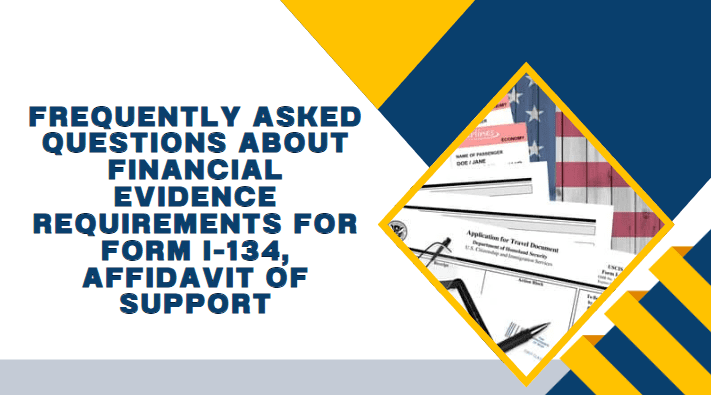• What is Form I-134?
Form I-134 , Affidavit of Support, is used by a U.S. sponsoring party to demonstrate financial capability to support an immigrant. It’s a declaration to the U.S. government that the sponsor can financially support the intending immigrant if necessary.
• Who needs to submit Form I-134?
Typically, this form is needed for individuals seeking to sponsor a prospective nonimmigrant applying for a visa. This form is most commonly used in a K-1 fiancé(e) visa case or a humanitarian parole request.
• Why is financial evidence required?
Financial evidence is necessary to assure the U.S. government that the foreign national will not become reliant on financial support from government services upon arrival in the United States.
• What types of financial documents should be submitted with Form I-134?
The sponsor must provide financial evidence such as tax transcripts or returns, bank statements, pay stubs, and a letter from their employer verifying their employment. These documents prove the sponsor has sufficient income or financial resources.
• How much income is required to support an affidavit of support?
The sponsoring individual must demonstrate they meet or exceed 100% of the U.S. federal poverty guidelines for the sponsor’s household size. This ensures financial capability.
• Can assets be used to qualify, and what is considered an asset?
Yes, assets such as real estate, stocks, bonds, and other possessions can be used if income is insufficient. The assets should be detailed and documented clearly to substitute income requirements. However, assets are calculated differently.
The value of assets is calculated by considering their liquidation value (i.e., how much they would be worth if converted to cash) and whether they can be readily accessed or used to support the visa applicant. For example, savings accounts and stocks are easy to calculate because you should report the current balance or value at the time of submitting Form I-134. However, real estate is a bit different. If you own property, you should report the equity of the property which is the current market value of the property minus any mortgage or loan amounts owed on the property.
Once you have the value of your assets, it should be 5 times the difference between your annual income and the income required to meet the 100% threshold. For example, if you are required to earn $30,000 annually and you currently earn $27,000. The difference between the two figures is $3,000. If you multiple that difference of $3,000 by 5, that results in $15,000. $15,000 is what you need to show in assets.
• Do I need a lawyer to prepare Form I-134?
Although hiring an attorney to fill out Form I-134 is not required, consulting an immigration lawyer can provide guidance on complex financial matters and help prevent errors that might lead to application denial.
• What should I do if I don’t meet the financial requirements?
Consider seeking a joint sponsor, who will also submit another Form I-134, providing supplemental financial evidence on your behalf.
• Where do I file Form I-134?
The form is usually submitted along with the foreign national’s visa application. Filing instructions can vary depending on where the individual is applying, so checking specific USCIS, embassy or consulate requirements is essential.
• How can I check the status of my affidavit of support?
If filed with USCIS, you can check the status using the USCIS online portal or contact them by phone. Having your receipt number handy will facilitate the process.
• What happens if there are changes to my financial situation after submitting Form I-134?
You must report any significant changes in financial status to USCIS, as it might affect the review process. Prompt communication is crucial to maintaining credibility and ensuring the application process remains smooth.



